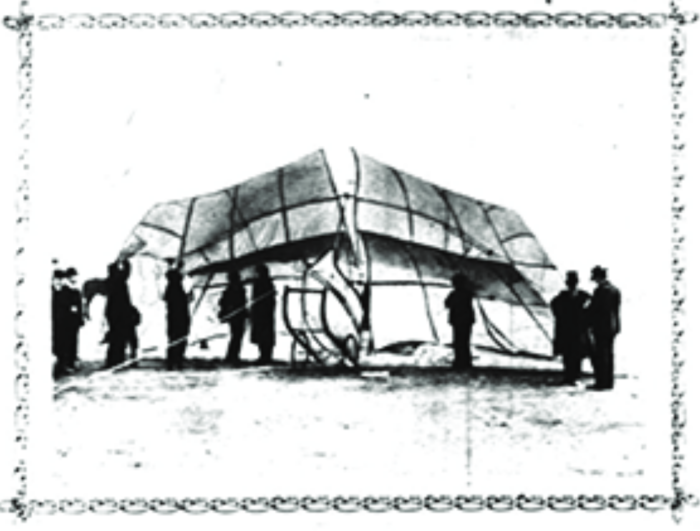N. R. Gordon was behind the Chowder Bay flying machine, but who was N. R. Gordon? His full name was Newton Roberts Gordon, and he emigrated from Britain in 1882.1 Although he described himself on a 1900 patent application as an ‘engineer’, and worked at one point as a mining engineer, it’s not clear if he had any formal training.2 He was, though, said to be ‘an exceptionally clever mechanical draughtsman’ who did ‘professional work for various civil engineers’.3 This no doubt helped him to draw up plausible blueprints, and he certainly had a penchant for invention — besides aviation–related patents, he also dabbled in motion picture technology.
In 1894, Gordon claimed to have been interested ‘fighting the air for 20 years’; in 1907 he was said to have put ’30 years’ work’ into aviation.4 So he presumably had been interested in aeronautics from the 1870s, before he emigrated. However, the earliest surviving evidence for his aviation interests (that I’ve found, at least) is from February 1893:
A number of ladies and gentlemen assembled at South Head on Saturday afternoon [25 February 1893] to witness a preliminary experiment with a flying machine. The machine is the invention of Mr N. R. Gordon, of Sydney, and when complete is to be propelled by wings obtaining their motive power from a steam engine, indicating five horse-power, the boiler of which will be so constructed and fixed as to form the backbone of the birdlike machine. Saturday’s experiment was merely with a roughly constructed model of the machine, without any propelling power, but carrying about 60lb of deadweight lashed amidships.5
This is evidently a smaller, unpowered version of the Chowder Bay machine; according to a later account it was ‘a bird-like structure with four scythe-like wings, having a spread of 16ft, covering an area of 46 square feet’.6 In February, a wing was damaged while being pushed over the cliff, preventing the trial from taking place; but the following month it actually flew:
The model, taking an almost straight dive from the cliff, sailed horizontally 150ft out, till the wind, or more probably the strong in-draught of air under the high cliff, drove it sideways, when it swung to the loft like a pendulum, and flew back in a straight line to the cliff.7
This was 18 March 1893, according to another account.8 So Gordon was working to an experimental programme: build a scale model first, test it, then scale it up and build the real thing. Except that launching model aircraft over the side of a cliff is probably not the best way to work out any kinks — unless you’re happy to keep rebuilding your flying machine every time.
Gordon didn’t give up after his big shot at flight failed at Chowder Bay. In 1900 he applied to the NSW Justice Department for protection (i.e. a patent) for his invention of ‘Improvements in aerial machines’.9 Interestingly, he gives as his purpose ‘the construction of such machine[s] as may be used for observation in time of war or other purpose where considerable elevation is required’:
I attach a pair of wings to my body by means of a suitable belt with proper fastenings in such a manner that my body forms the main frame work of the structure and in such a way that the weight of my body is suspended below the wing bones and material of the wings, and in a central line between the wings. I make the wings concave near the body gradually flattening towards the extremities.10
As far as I can tell, this is a human-powered ornithopter. Whether that’s an advance over an underpowered steam ornithopter is debatable, though it seems Gordon envisaged this as a step (back) towards something bigger:
One, two, or more pairs of wings may be used with a larger machine for carrying passengers which would be driven by steam, electricity, compressed air, or other motive power.11
Whether or not it was ever built, presumably this patent led to Gordon’s next flying machine, in 1907, this time at Footscray, in Melbourne’s western suburbs. Which I’ll get to next time!
![]() This work is licensed under a Creative Commons Attribution-NonCommercial-NoDerivatives 4.0 International License.
Permissions beyond the scope of this license may be available at http://airminded.org/copyright/.
This work is licensed under a Creative Commons Attribution-NonCommercial-NoDerivatives 4.0 International License.
Permissions beyond the scope of this license may be available at http://airminded.org/copyright/.
- Sylvia Black, ‘Dreaming the impossible dream’, East Melbourne Historical Society Newsletter, June 2016, 6-7. Though brief, this is the best source for Gordon’s life. See also David Craddock, ‘Antipodean aeronautica’, Journal & Proceedings of the Royal Society of New South Wales 135 (2002): 1–15; The Aerodrome. [↩]
- National Archives of Australia [NAA], A4618, 10449, ‘Correspondence with Newton Roberts Gordon concerning invention entitled – Improvements in aerial machines’; Evelyn Observer, 30 August 1907, 2. [↩]
- Table Talk (Melbourne), 16 May 1907, 7. [↩]
- Daily Telegraph (Sydney), 2 October 1894, 3; Singleton Argus, 14 May 1907, 3. [↩]
- Daily Telegraph (Sydney), 27 February 1893, 4. [↩]
- Daily Telegraph (Sydney), 24 March 1893, 2. [↩]
- Goulburn Herald, 24 March 1893, 2. [↩]
- National Advocate (Bathurst), 21 March 1893, 2. [↩]
- NAA, A4618, 10449, ‘Correspondence with Newton Roberts Gordon concerning invention entitled – Improvements in aerial machines’ [↩]
- Ibid. [↩]
- Ibid. [↩]



